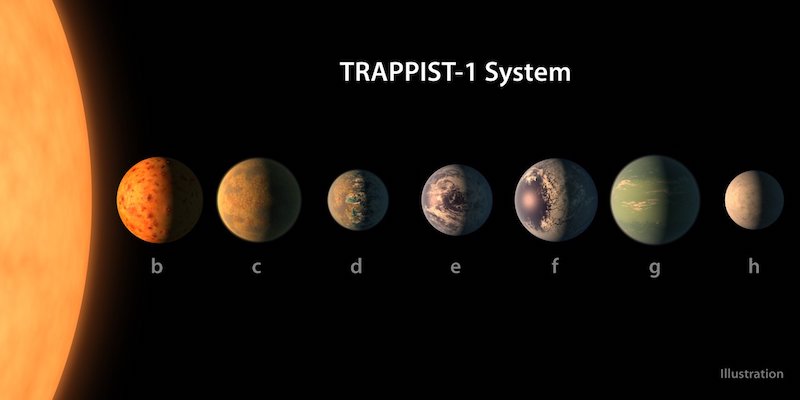
Webb telescope’s 1st observations of TRAPPIST-1
NASA’s new Webb space telescope began observing the nearby and fascinating TRAPPIST-1 exoplanet system last June. And now the initial highly-anticipated first results are in. Astronomer Björn Benneke of the University of Montreal announced them on December 13, 2022, at the Space Telescope Science Institute symposium in Baltimore, Maryland. As Benneke said to the audience of astronomers:
We’re in business.
And veteran science journalist Alexandra Witze then reported on Benneke’s announcement in Nature, the next day. The associated science papers have not been published yet, but will be starting in early 2023.
Why the hubbub? The fact is that TRAPPIST-1 is one of the most eagerly anticipated targets for Webb. The system contains no fewer than seven rocky planets, all similar in size to Earth. At least three of the planets are in this star’s habitable zone, where temperatures could allow liquid water to exist. The other planets are also close to the habitable zone. All at only 39 light-years away.
The new Webb findings are preliminary. So they don’t answer the question of whether any of the seven rocky planets – all similar in size to Earth – could support life … yet. But they do show the potential for Webb to study this beguiling nearby system.
TRAPPIST-1b and TRAPPIST-1g
The initial observations focused on two of the planets, TRAPPIST-1b and TRAPPIST-1g. Planet b is the closest to the star and planet g is the second farthest (with TRAPPIST-1h being the farthest).
TRAPPIST-1g is the largest of the planets, with a radius 1.154 times that of Earth. The results, so far, indicate that it is unlikely to have a deep primordial hydrogen atmosphere. Larger gas and ice giants, like Jupiter or Neptune in our own solar system, tend to have such atmospheres. This means that TRAPPIST-1g could have a thinner, more terrestrial-type atmosphere, like that of Earth, Venus or Mars. If so, that would be good for the prospects of possible life, since those are secondary atmospheres, ones that have undergone significant chemical alterations over millions or billions of years. For example, Earth’s primarily nitrogen atmosphere is largely due to life processes changing it over time.
More observations needed
More observations will be needed, however, to determine just what TRAPPIST-1g’s atmosphere is like, if it does have one. This is because the TRAPPIST-1 planets are small, close to their star and far away (39 light-years). Even with Webb it requires several orbits of the planet, where it transits in front of its star, to analyze the atmosphere in detail. Larger exoplanets, like WASP-39b, are easier to study.
The same is even more true for TRAPPIST-1b, since it is a little smaller and the closest to its star. As Witze wrote:
Olivia Lim of the University of Montreal showed two JWST [Webb] observations of the innermost planet in the system, TRAPPIST-1b. She, too, has not been able to tease out a signal indicating the planet’s atmosphere just yet. But preliminary studies suggest that it, like planet 1g, probably doesn’t have a puffy, hydrogen-rich atmosphere.

A TRAPPIST-1 family portrait
While these first results may not sound too exciting, rest assured that much more is coming about all seven planets. In fact, as Knicole Colon, an astronomer at NASA’s Goddard Space Flight Center, noted:
Within the next year we’ll have a family portrait.
It will be interesting to see just how many of the seven planets do actually have atmospheres (if any) and how they compare to each other. There is some concern that at least some of the planets may have lost their atmospheres. This is due to the fact that they orbit a red dwarf star. Red dwarfs are known for being highly active, emitting intense solar flares that can strip a planet of its atmosphere if it is too close. This is still a subject of much debate, however. A study from 2021 showed that many red dwarf planets may actually be safe from solar flares after all.
TRAPPIST-1 at the 241st Meeting of the American Astronomical Society
There will also be updates about both TRAPPIST-1b and TRAPPIST-1g given at the upcoming 241st Meeting of the American Astronomical Society in Seattle, Washington (January 8-12, 2023).
From the abstract for TRAPPIST-1b:
In this talk, we present the first high-precision transit spectra of the warm Earth-sized planet TRAPPIST-1b based on two transit observations using NIRISS in SOSS mode on the James Webb Space Telescope. TRAPPIST-1b is the most favorable Earth-sized planet for characterization via transmission spectroscopy among all exoplanets. As such, our observations have the sensitivity to detect a wide range of atmospheres, providing unprecedented insight into the potentially secondary atmosphere on a rocky Earth-sized planet outside the solar system.
From the abstract for TRAPPIST-1g:
The rocky exo-Earth TRAPPIST-1g is particularly well-suited for this kind of first study because the low stellar insolation can allow for habitable conditions on its surface, while the small host star strongly amplifies the observable spectroscopic transit signature compared to planets orbiting sun-like stars. Here, we present the first high-precision JWST transmission spectrum of a habitable-zone exo-Earth, the planet TRAPPIST-1g, covering the full spectra range between 0.6-5.3µm, obtained through two JWST transits observations using the NIRSpec PRISM BOTS mode.
The sensitivity of these observations is sufficient to detect secondary terrestrial atmospheres of a wide range of compositions, with molecular bands of CO2, H2O, CH4, NH3, and SO2 plausibly directly detectable if present.
2023 should be an interesting and exciting year for anyone who has been following the discovery and subsequent studies of the TRAPPIST-1 system. What will Webb discover?
Bottom line: Researchers have announced the results from Webb’s 1st glimpse of the TRAPPIST-1 exoplanet system, which contains seven Earth-sized potentially habitable worlds.











